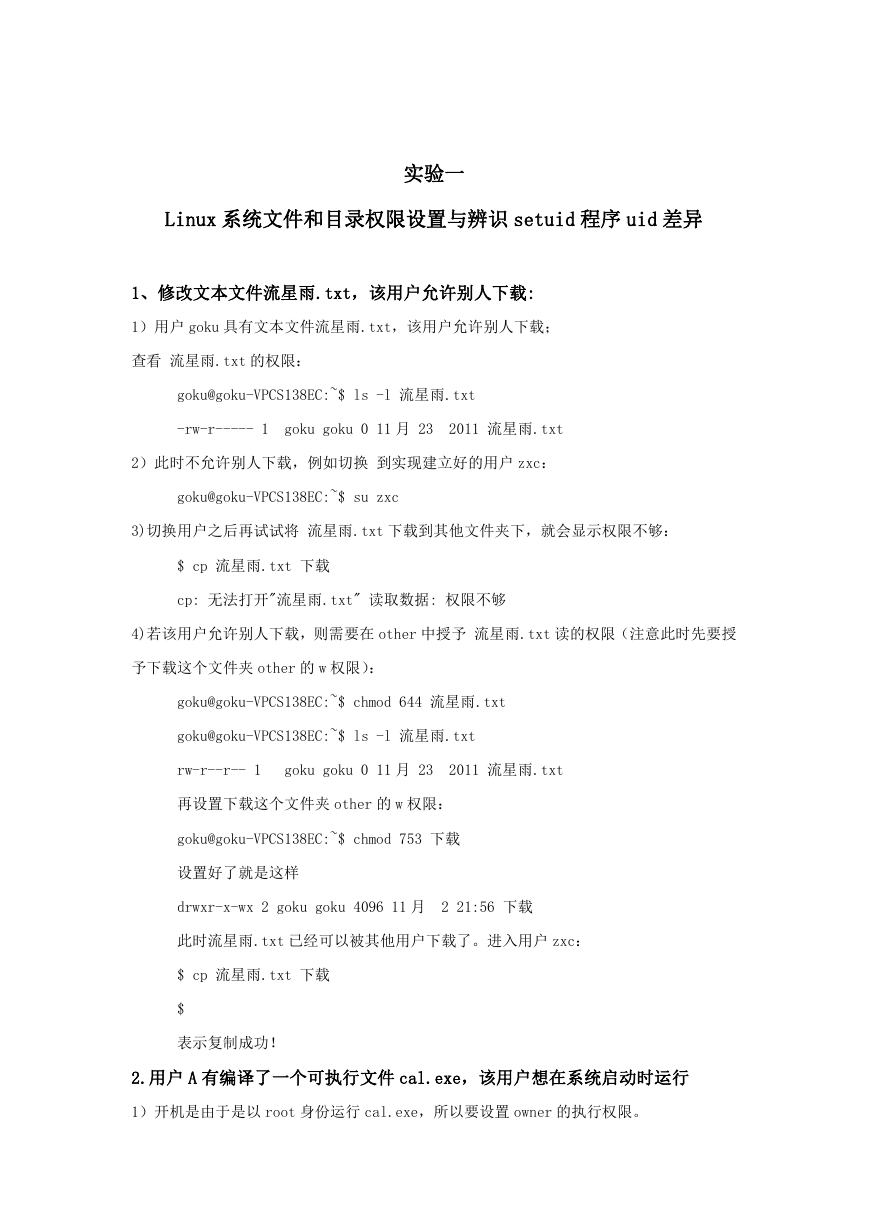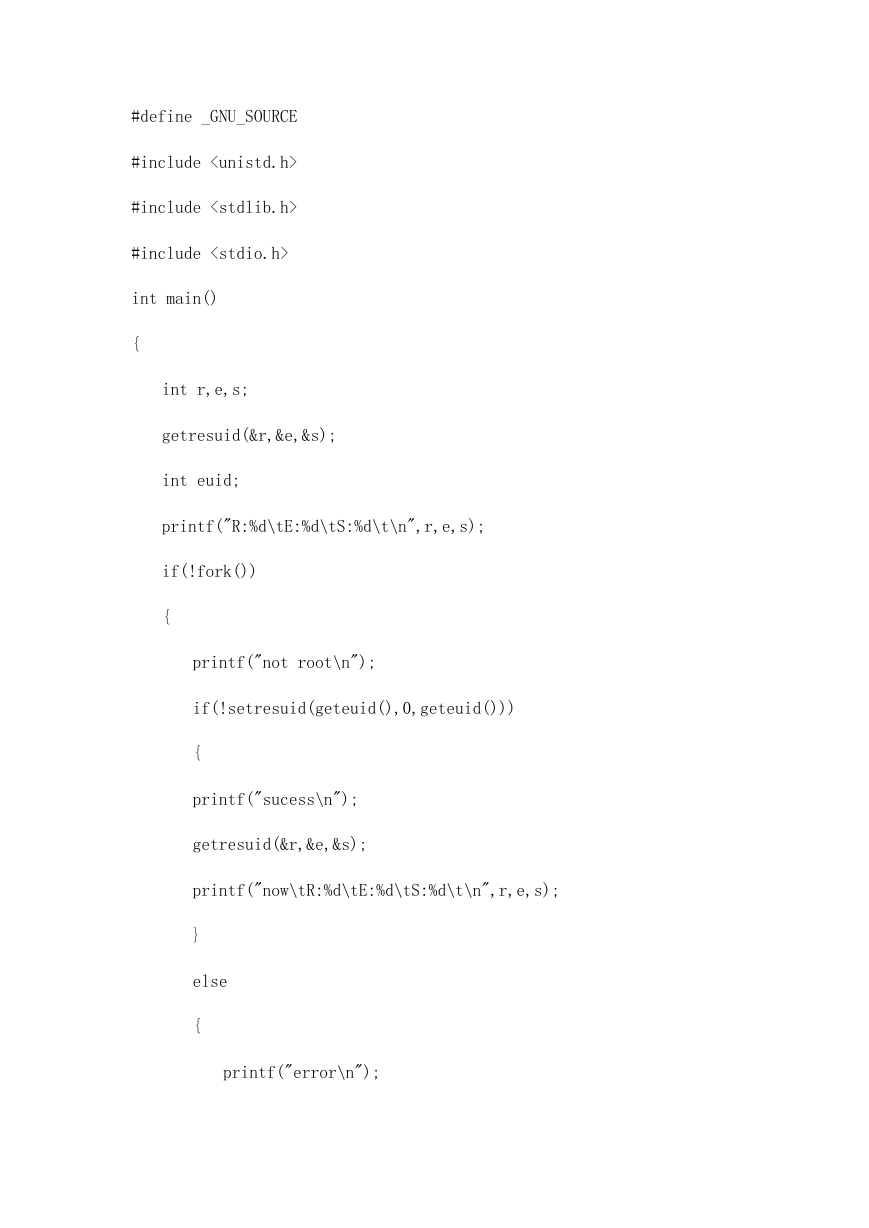实验一
Linux 系统文件和目录权限设置与辨识 setuid 程序 uid 差异
1、修改文本文件流星雨.txt,该用户允许别人下载:
1)用户 goku 具有文本文件流星雨.txt,该用户允许别人下载;
查看 流星雨.txt 的权限:
goku@goku-VPCS138EC:~$ ls -l 流星雨.txt
-rw-r----- 1
goku goku 0 11 月 23
2011 流星雨.txt
2)此时不允许别人下载,例如切换 到实现建立好的用户 zxc:
goku@goku-VPCS138EC:~$ su zxc
3)切换用户之后再试试将 流星雨.txt 下载到其他文件夹下,就会显示权限不够:
$ cp 流星雨.txt 下载
cp: 无法打开"流星雨.txt" 读取数据: 权限不够
4)若该用户允许别人下载,则需要在 other 中授予 流星雨.txt 读的权限(注意此时先要授
予下载这个文件夹 other 的 w 权限):
goku@goku-VPCS138EC:~$ chmod 644 流星雨.txt
goku@goku-VPCS138EC:~$ ls -l 流星雨.txt
rw-r--r-- 1
goku goku 0 11 月 23
2011 流星雨.txt
再设置下载这个文件夹 other 的 w 权限:
goku@goku-VPCS138EC:~$ chmod 753 下载
设置好了就是这样
drwxr-x-wx 2 goku goku 4096 11 月 2 21:56 下载
此时流星雨.txt 已经可以被其他用户下载了。进入用户 zxc:
$ cp 流星雨.txt 下载
$
表示复制成功!
2.用户 A 有编译了一个可执行文件 cal.exe,该用户想在系统启动时运行
1)开机是由于是以 root 身份运行 cal.exe,所以要设置 owner 的执行权限。
�
goku@goku-VPCS138EC:~$ chmod 744 cal.exe
goku@goku-VPCS138EC:~$ ls -ll cal.exe
-rwxr--r-- 1 goku goku 0 11 月 23
2011 cal.exe
3.用户 A 有起草了文件 demo.txt,想让同组的用户帮其修改文件;
goku@goku-VPCS138EC:~$ ls -l demo.txt
-rw----r-- 1 goku goku 0 11 月 23
2011 demo.txt
进入事先建立好的与 lenovo-xq 同组的用户 asd:
$ id asd
uid=1005(asd) gid=1005(asd) 组=1005(asd),1000(goku) (从这里可以看出 asd 与
goku 一组)
goku@goku-VPCS138EC :~$ su asd
密码:
$ vim demo.txt
进入 vim 编辑的时候就会出现
E138: 无法写入 viminfo 文件 /home/asd/.viminfo!
修改 demo.txt 组内的读和写的权限,文件就可以编辑和修改了:
goku@goku-VPCS138EC:~$ chmod 664 demo.txt
goku@goku-VPCS138EC :~$ ls -l demo.txt
-rw-rw-r-- 1 goku goku 0 11 月 23
2011 demo.txt
4.设计并实现 setuid 程序的使用,并分析不同用户 fork 调用 setuid 程序后
euid、ruid、suid 的差别,以及用户调用 execl 执行 setuid 程序后 euid、ruid、
suid 的差别。
real user ID 表示的是实际上进程的执行者是谁,effective user ID 主要用于校验该进程
在执行时所获得的文件访问权限,也就是说当进程访问
文件时检查权限时实际上检查的该进程的"effective user ID",saved set-user-ID 仅在
effective user ID 发生改变时保存.
�
一般情况下,real user ID 就是进程的 effective user ID,但是当要运行的可执行程序设置
了"set-user-ID"位之后,进程的 effective user ID
变成该文件的属主用户 id,同时该进程的"saved set-user-ID"变成此时进程的"effective
user ID",也就是该可执行程序的属主用户 ID,该进程
在执行一些与文件访问权限相关的操作时系统检查的是进程的 effective user ID.
当进程没有超级用户权限的时候,进程在设置"effective user ID"时需要将需要设置的 ID
和该进程的"real user ID"或者"saved set-user-ID"进行比较.
也就是说:
1)当用户具有超级用户权限的时候,setuid 函数设置的 id 对三者都起效.
2)否则,仅当该 id 为 real user ID 或者 saved set-user-ID 时,该 id 对 effective user ID
起效.
3)否则,setuid 函数调用失败.
这个 saved set-user-ID 更多的作用是在进程切换自己的 effective user ID 起作用.
举一个例子说明问题,假设这样的一种情况,系统中有两个用户 A,B,还有一个由 B 创建的可
执行程序 process,该可执行程序的 set-user-id 位已经进行了设置.
当 A 用户执行程序 process 时,
程序的 real user ID = A 的用户 ID,effective user ID = B 的用户 ID,
saved
set-user-ID=B 的用户 ID.
假如在该进程结束了对某些限制只能由用户 B 访问的文件操作后,程序将 effective user ID
设置回 A,也就是说此时:
程序的 real user ID = A 的用户 ID,effective user ID = A 的用户 ID,
saved
set-user-ID=B 的用户 ID.
以只能通过两种途径获得(可能还有别的途径):
setuid(设置真实的用户识别码)
�
相关函数 getuid,setreuid,seteuid,setfsuid
表头文件 #include
定义函数 int setuid(uid_t uid)
函数说明 setuid()用来重新设置执行目前进程的用户识别码。不过,要让
此函数有作用,其有效的用户识别码必须为 0(root)。在 Linux
下,当 root 使用 setuid()来变换成其他用户识别码时,root 权
限会被抛弃,完全转换成该用户身份,也就是说,该进程往后将
不再具有可 setuid()的权 利,如果只是向暂时抛弃 root 权限,
稍后想重新取回权限,则必须使用 seteuid()。
返回值 执行成功则返回 0,失败则返回-1,错误代码存于 errno。
附加说明 一般在编写具 setuid root 的程序时,为减少此类程序带来的系
统安全风险,在使用完 root 权限后建议马上执行
setuid(getuid());来抛弃 root 权限。此外,进程 uid 和 euid 不
一致时 Linux 系统将不会产生 core dump。
普通用户:goku
1.getresuid()
2.setresuid(getuid,0,getuid)
3.setresuid(getuid,getuid,0)
4.setresuid(0,0,getuid)
5.setresuid(getuid,getuid,getuid)
6.setresuid(0,0,0)
return 0;
#include
#include
�
#define _GNU_SOURCE
#include
#include
#include
int main()
{
int r,e,s;
getresuid(&r,&e,&s);
int euid;
printf("R:%d\tE:%d\tS:%d\t\n",r,e,s);
if(!fork())
{
printf("not root\n");
if(!setresuid(geteuid(),0,geteuid()))
{
printf("sucess\n");
getresuid(&r,&e,&s);
printf("now\tR:%d\tE:%d\tS:%d\t\n",r,e,s);
}
else
{
printf("error\n");
�
}
if(!setresuid(geteuid(),geteuid(),0))
{
printf("sucess\n");
getresuid(&r,&e,&s);
printf("now\tR:%d\tE:%d\tS:%d\t\n",r,e,s);
}
else
{
}
printf("error\n");
if(!setresuid(geteuid(),0,0))
{
printf("sucess\n");
getresuid(&r,&e,&s);
printf("now\tR:%d\tE:%d\tS:%d\t\n",r,e,s);
}
else
{
}
printf("error\n");
if(!setresuid(geteuid(),geteuid(),geteuid()))
�
{
printf("sucess\n");
getresuid(&r,&e,&s);
printf("now\tR:%d\tE:%d\tS:%d\t\n",r,e,s);
}
else
printf("error\n");
{
}
}
wait(NULL);
return 0;
}
root@goku-VPCS138EC:/home/goku# gcc -o yan yan.c
root@goku-VPCS138EC:/home/goku# su goku
goku@goku-VPCS138EC:~$ ./yan
R:1000
E:1000
S:1000
not root
error
error
error
sucess
S:1000
E:1000
now R:1000
经过测试得出,当用户为普通用户时,srtresuid 只能设置为 ruid,euid,suid 中的一个,
而不能设置为 0,或者其他 uid,并且子进程完全继承父进程的 uid。非 root 用户是不可能
通过 setresuid 取得其他权限(包括 root 权限)的,它只能恢复原来的权限。允许通过
�
setresuid 取得 root 权限是非常危险的,这样就可以在程序的后边做任何想做的事了(包
括 kill 掉你的进程,系统)。
root 用户:
1.getresuid()
2.id=GetPasswdId(char *name)
3.setresuid(id,id,0)
4.setresuid(id,0,id)
5.setresuid(id,id,id)
6.setresuid(0,0,0)
return 0;
#include
#include
#define _GNU_SOURCE
#include
#include
#include
int GetPasswdId(const char *name)
{
�
















 2023年江西萍乡中考道德与法治真题及答案.doc
2023年江西萍乡中考道德与法治真题及答案.doc 2012年重庆南川中考生物真题及答案.doc
2012年重庆南川中考生物真题及答案.doc 2013年江西师范大学地理学综合及文艺理论基础考研真题.doc
2013年江西师范大学地理学综合及文艺理论基础考研真题.doc 2020年四川甘孜小升初语文真题及答案I卷.doc
2020年四川甘孜小升初语文真题及答案I卷.doc 2020年注册岩土工程师专业基础考试真题及答案.doc
2020年注册岩土工程师专业基础考试真题及答案.doc 2023-2024学年福建省厦门市九年级上学期数学月考试题及答案.doc
2023-2024学年福建省厦门市九年级上学期数学月考试题及答案.doc 2021-2022学年辽宁省沈阳市大东区九年级上学期语文期末试题及答案.doc
2021-2022学年辽宁省沈阳市大东区九年级上学期语文期末试题及答案.doc 2022-2023学年北京东城区初三第一学期物理期末试卷及答案.doc
2022-2023学年北京东城区初三第一学期物理期末试卷及答案.doc 2018上半年江西教师资格初中地理学科知识与教学能力真题及答案.doc
2018上半年江西教师资格初中地理学科知识与教学能力真题及答案.doc 2012年河北国家公务员申论考试真题及答案-省级.doc
2012年河北国家公务员申论考试真题及答案-省级.doc 2020-2021学年江苏省扬州市江都区邵樊片九年级上学期数学第一次质量检测试题及答案.doc
2020-2021学年江苏省扬州市江都区邵樊片九年级上学期数学第一次质量检测试题及答案.doc 2022下半年黑龙江教师资格证中学综合素质真题及答案.doc
2022下半年黑龙江教师资格证中学综合素质真题及答案.doc